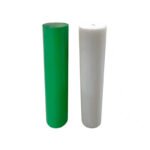
What are the advantages of UHMWPE?
April 1, 2025In the world of industrial materials, both HDPE (High-Density Polyethylene) and UHMWPE (Ultra-High-Molecular-Weight Polyethylene) are commonly used for a variety of applications. Although they both belong to the same family of polyethylene plastics, they have distinct properties and are suitable for different uses. In this blog, we’ll take a deep dive into these two materials, exploring their characteristics, applications, and more.
1. What is HDPE?
High-Density Polyethylene (HDPE) is a thermoplastic polymer made from petroleum. Known for its high strength-to-density ratio, HDPE is a versatile material used in a wide range of applications. Its molecular structure consists of tightly packed polymer chains, giving it a high level of rigidity and strength. HDPE is commonly used in products such as plastic bottles, pipes, and containers.
2. What is UHMWPE?
Ultra-High-Molecular-Weight Polyethylene (UHMWPE) is a type of polyethylene with an extremely high molecular weight. This gives it exceptional durability and strength compared to other forms of polyethylene, including HDPE. UHMWPE is known for its low friction, wear resistance, and impact strength. It is used in a variety of high-performance applications, from medical devices to industrial machinery.
3. HDPE Material Characteristics
HDPE is recognized for its strength, durability, and versatility. Some of its key characteristics include:
- High tensile strength: HDPE is strong and resistant to stress and damage.
- Chemical resistance: It resists a wide range of chemicals, making it ideal for containers and pipes that store or carry chemicals.
- Low moisture absorption: This property makes HDPE suitable for outdoor applications as it does not easily absorb water.
- Weather and UV resistance: HDPE can withstand prolonged exposure to the sun and extreme weather conditions.
- Easy to process: HDPE can be molded, extruded, or fabricated into various shapes.
4. UHMWPE Material Characteristics
UHMWPE has even more impressive properties than HDPE, particularly in applications that require exceptional durability. Key characteristics of UHMWPE include:
- Ultra-high molecular weight: This gives UHMWPE remarkable toughness, strength, and wear resistance.
- Low coefficient of friction: UHMWPE has one of the lowest friction coefficients of any plastic, making it perfect for applications where smooth movement is required.
- Exceptional impact resistance: UHMWPE can absorb high amounts of shock without cracking or breaking.
- Chemical resistance: Like HDPE, UHMWPE is resistant to most chemicals, including corrosive substances.
- Low moisture absorption: UHMWPE also has low moisture absorption, which helps prevent degradation over time.
5. HDPE Applications
Thanks to its strength, durability, and cost-effectiveness, HDPE is used in a variety of industries. Some common applications include:
- Packaging: HDPE is commonly used in packaging materials such as bottles, containers, and plastic bags.
- Piping systems: It is widely used for water and gas pipes due to its chemical resistance and ability to withstand pressure.
- Toys and household products: From children’s toys to cutting boards, HDPE is found in many everyday products.
- Agriculture: HDPE is used in farming applications like irrigation systems and greenhouse covers.
6. UHMWPE Applications
Given its superior mechanical properties, UHMWPE is used in specialized applications where high performance is required. Some common applications of UHMWPE include:
- Medical devices: UHMWPE is used in implants and prosthetics, especially in joint replacements.
- Aerospace: UHMWPE is used in parts of aircraft and other high-performance equipment where weight and strength are crucial.
- Mining and material handling: The material is used for chute liners, wear plates, and other components exposed to harsh conditions.
- Marine: UHMWPE is used in applications such as dock fenders, liners for ship hulls, and other parts that need to resist wear from saltwater exposure.
7. HDPE Common Brands
There are several brands that produce HDPE products known for their quality and performance. Some common brands of HDPE include:
- Chevron Phillips Chemical: Known for producing high-quality HDPE resins for various industries.
- Dow Chemical: A major manufacturer of HDPE used in packaging, agriculture, and piping.
- ExxonMobil: A leading brand in the production of HDPE, providing products for packaging and industrial applications.
- INEOS: Specializes in high-performance HDPE for uses ranging from industrial to consumer goods.
8. UHMWPE Common Brands
Similar to HDPE, UHMWPE is produced by several renowned brands. These include:
- Celanese: Known for manufacturing high-quality UHMWPE used in demanding applications such as medical and industrial uses.
- DSM Engineering Plastics: A leader in advanced polymers, producing UHMWPE products for industrial and aerospace applications.
- Quadrant: Known for UHMWPE sheets and rods used in the material handling, mining, and food processing industries.
- Trelleborg: A prominent supplier of UHMWPE solutions for various industries, including mining and construction.
9. Typical Properties of HDPE vs. UHMWPE
When comparing HDPE and UHMWPE, it’s clear that both materials offer unique advantages, but they differ significantly in certain properties. Here’s a quick comparison:
| Property | HDPE | UHMWPE |
| Molecular Weight | Medium to high | Extremely high |
| Tensile Strength | High | Very high |
| Impact Resistance | Good | Exceptional |
| Wear Resistance | Good | Superior |
| Chemical Resistance | Excellent | Excellent |
| Friction Coefficient | Moderate | Very low |
| UV Resistance | Good | Excellent |
| Common Uses | Packaging, pipes, containers | Medical implants, mining, aerospace |
Conclusion
Both HDPE and UHMWPE are versatile and reliable materials, but each serves a different set of needs depending on the application. HDPE is an excellent choice for applications that require strength, chemical resistance, and ease of processing. In contrast, UHMWPE is ideal for more demanding uses where extreme durability, wear resistance, and low friction are critical.
Choosing between these two materials depends on the specific requirements of your project, such as load-bearing capacity, exposure to chemicals, or need for low friction. By understanding the differences, you can select the most suitable material for your application.


